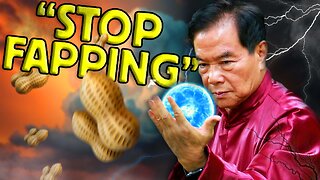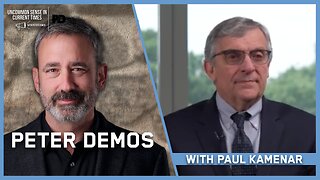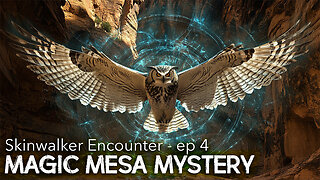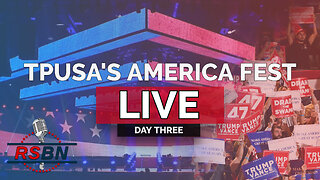Premium Only Content

Drew Carey Christmas not in the Bible not Jesus day
The video seems to feature a comedic monologue addressing the incongruities between popular holidays and their biblical or historical origins. The speaker expresses disillusionment with the news, seeking solace in religious texts. They humorously note the apocalyptic signs from the Book of Revelation reflected in current events. The monologue critiques the commercialization of Christmas and Easter, pointing out their pagan roots and lack of biblical endorsement for the traditions associated with them, such as Christmas trees and the Easter Bunny. The speaker also touches on Halloween’s acceptance despite its association with the occult. Finally, there is a controversial joke about the Catholic Church and its scandals, suggesting that even negative attention can be publicity.
The key points reference:
• The disparity between the news and biblical prophecies.
• The commercial and non-biblical nature of Christmas and Easter traditions.
• The cultural acceptance of Halloween despite its satanic connections.
• A satirical take on the notion that all publicity is good publicity, in relation to the Catholic Church.
For validation and deeper understanding of these points, one could reference:
• Historical texts on the origins of Christmas and Easter, which are often linked to pagan traditions.
• Biblical scripture, specifically the Book of Revelation, to compare with current events mentioned in the monologue.
• Studies on the commercialization of religious holidays and its effects on societal and religious practices.
Santa Claus and the Easter Bunny are figures associated with the cultural and commercial celebration of Christmas and Easter, respectively. They are not derived from biblical scripture but have become emblematic of these holidays in many parts of the world.
Santa Claus:
Santa Claus, also known as Saint Nicholas, Father Christmas, Kris Kringle, or simply Santa, is a legendary figure originating in Western Christian culture who is said to bring gifts to the homes of well-behaved children on Christmas Eve (December 24) or during the early morning hours of Christmas Day (December 25). The modern character of Santa Claus was based on traditions surrounding the historical Saint Nicholas, a 4th-century Greek bishop and gift-giver of Myra, the British figure of Father Christmas, and the Dutch figure of Sinterklaas. Some of Santa’s attributes are borrowed from Norse mythology, particularly the god Odin.
Script Example for Santa Claus:
“Every year, as the snow blankets the ground and the sound of carols fills the air, children around the world pen their wishes to the jolly man in the red suit. Santa Claus, a symbol of generosity and joy, embodies the spirit of Christmas by rewarding good behavior with the magic of surprise gifts. He represents the idea of giving without expectation, spreading cheer, and the importance of kindness and wonder in the hearts of all.”
Easter Bunny:
The Easter Bunny is a folkloric figure and symbol of Easter, depicted as a rabbit bringing Easter eggs. The rabbit, or hare, has long been a symbol of fertility and new life, which aligns with the themes of springtime and rebirth. The Easter Bunny’s origins are believed to have been in Germany, where tales of an egg-laying hare called “Osterhase” or “Oschter Haws” were told to children. Just as Santa Claus does for Christmas, the Easter Bunny plays a similar role for Easter in bringing baskets filled with colored eggs, candy, and sometimes also toys to the homes of children, and as such is a symbol of new life and rebirth that are part of the Easter tradition.
Script Example for Easter Bunny:
“As the chill of winter melts away and the warmth of spring takes its place, the Easter Bunny hops into the hearts of many. With a basket full of painted eggs and sweet treats, this cheerful rabbit is a herald of renewal and the joyous spirit of Easter. The Easter Bunny, while not a biblical figure, has become a beloved part of the holiday, encouraging family traditions and the celebration of life’s continuous renewal.”
Both characters have been integrated into holiday traditions in a way that makes them fun and engaging, especially for children, encouraging family bonding and the joy of giving.
The origins of Christmas and Easter traditions, specifically Santa Claus and the Easter Bunny, are a blend of various religious, cultural, and pagan elements that have evolved over centuries.
Santa Claus:
The figure of Santa Claus has its roots in several historical and mythical figures:
• Saint Nicholas: A 4th-century Christian bishop from Myra (modern-day Turkey), known for his generosity, especially towards children, and his secret gift-giving.
• Father Christmas: A figure from English folklore that represented the spirit of good cheer at Christmas, not necessarily a gift-bringer.
• Sinterklaas: A Dutch figure based on Saint Nicholas, who brought gifts to children.
• Norse Mythology: Some Santa traits are believed to be derived from the Norse god Odin, who was celebrated during the pagan holiday of Yule. Odin was said to lead a great hunting party through the sky during the Yule season.
Easter Bunny:
The Easter Bunny’s origins are less clear but are believed to have started in Germany:
• Germanic Paganism: The hare was a symbol associated with the pagan festival of Eostre, a goddess of spring and fertility. The festival celebrated the renewal of life and rebirth, which coincides with the Christian celebration of the resurrection of Jesus.
• Osterhase/Oschter Haws: A folklore figure that was a hare who laid colored eggs in nests prepared by children during the start of the season of Eastertide. The tradition was brought to America by German immigrants in the 1700s.
Both characters were likely incorporated into Christian holidays as part of a broader strategy to make the new religion more acceptable to pagan converts by blending Christian teachings with existing pagan traditions. Over time, these figures have been commercialized and secularized, becoming integral to the cultural celebration of these holidays.
-
 10:02
10:02
MichaelBisping
15 hours agoBISPING: "Was FURY ROBBED?!" | Oleksandr Usyk vs Tyson Fury 2 INSTANT REACTION
12.5K7 -
 8:08
8:08
Guns & Gadgets 2nd Amendment News
2 days ago16 States Join Forces To Sue Firearm Manufacturers Out of Business - 1st Target = GLOCK
63K60 -
 10:17
10:17
Dermatologist Dr. Dustin Portela
1 day ago $12.40 earnedOlay Cleansing Melts: Dermatologist's Honest Review
85.8K5 -
 1:02:20
1:02:20
Trumpet Daily
2 days ago $31.29 earnedObama’s Fake World Comes Crashing Down - Trumpet Daily | Dec. 20, 2024
54.5K40 -
 6:29
6:29
BIG NEM
1 day agoCultivating God Mode: Ancient Taoist NoFap Practices
42.9K9 -
 30:53
30:53
Uncommon Sense In Current Times
2 days ago $9.36 earned"Pardon or Peril? How Biden’s Clemency Actions Could Backfire"
61.6K4 -
 40:01
40:01
CarlCrusher
22 hours agoSkinwalker Encounters in the Haunted Canyons of Magic Mesa - ep 4
57.6K3 -
 59:44
59:44
PMG
1 day ago $7.55 earned"BETRAYAL - Johnson's New Spending Bill EXPANDS COVID Plandemic Powers"
62.5K26 -
 6:48:50
6:48:50
Akademiks
20 hours agoKendrick Lamar and SZA disses Drake and BIG AK? HOLD UP! Diddy, Durk, JayZ update. Travis Hunter RUN
184K33 -
 11:45:14
11:45:14
Right Side Broadcasting Network
9 days agoLIVE REPLAY: TPUSA's America Fest Conference: Day Three - 12/21/24
367K28